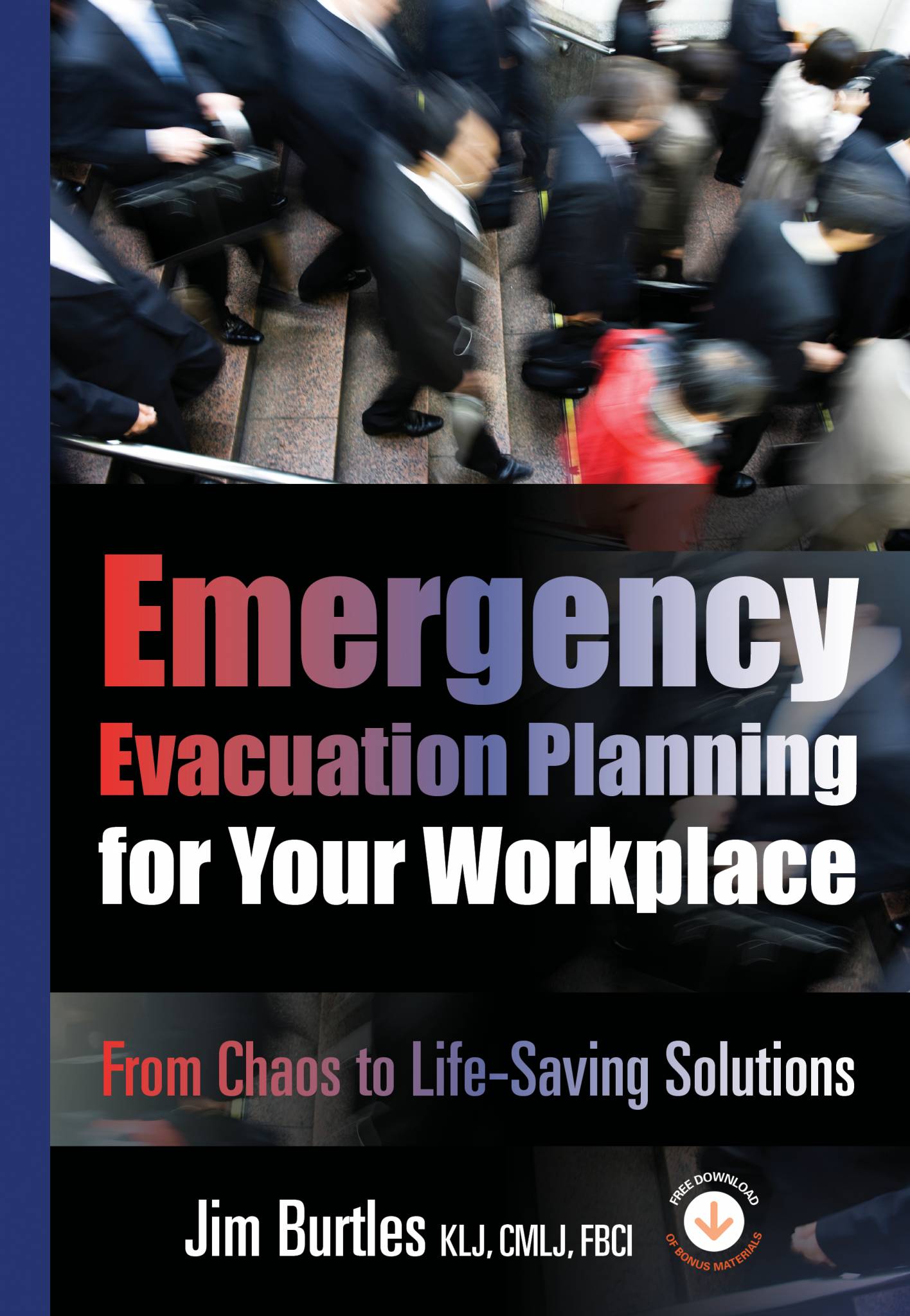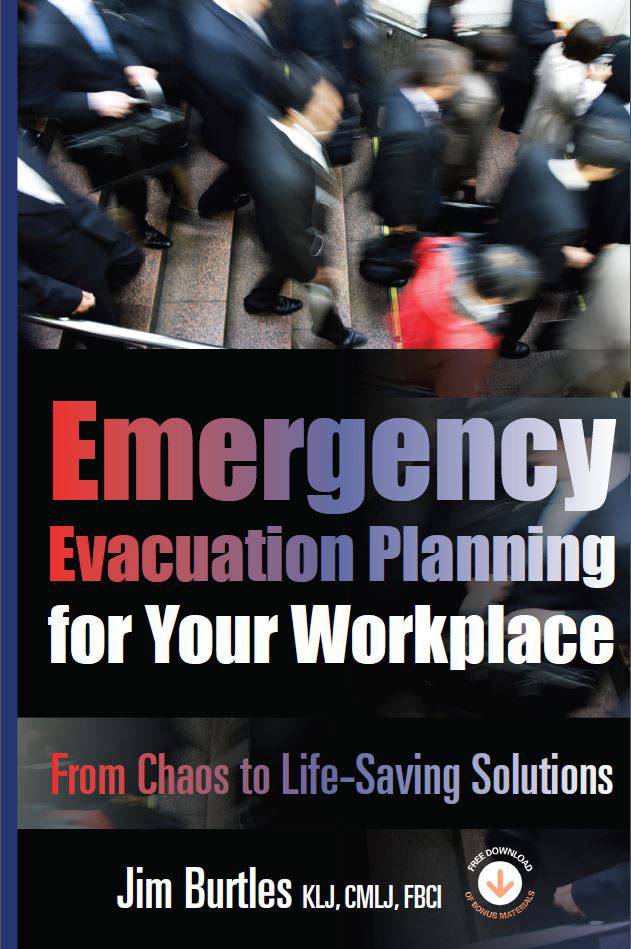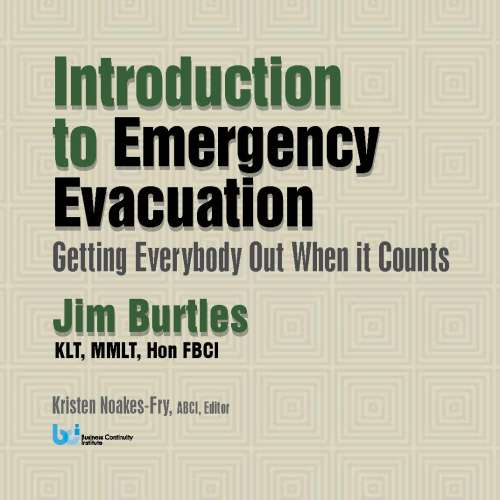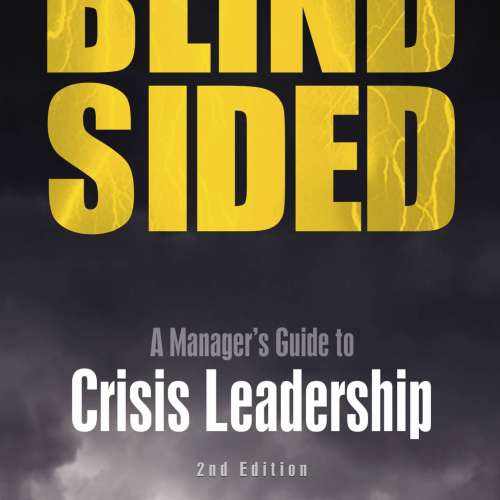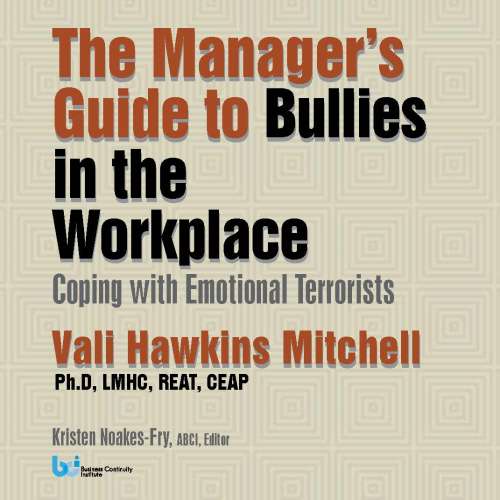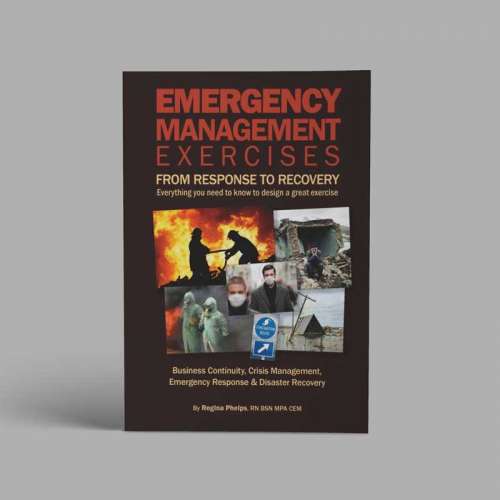Description
First ever, all-in-one, practical resource for emergency evacuation of people of all ages and health conditions from all kinds of workplaces, including small offices, skyscrapers, business and college campuses, industrial plants, stores, hospitals, and schools!
Comprehensive package of 600+ pages of book and downloadable resources!
Chaos ensues. Crowds become hysterical. Workers and visitors flee the burning building amid falling debris, run frantically through seemingly endless, smoke-filled hallways and stumble down crowded stairwells as fire alarms shriek through the darkness.
Panic sets in. No time for reflection. No time to figure out where to go!
Would your routine office fire drill be able to handle the large-scale chaos of a major disaster? Can you get everyone out safely in the face of a factory fire, explosion, or natural disaster? In Emergency Evacuation Planning for Your Workplace: From Chaos to Life-Saving Solutions, Jim Burtles leads you step-by-step through a planning methodology that saves lives. You can be assured your company will be ready and that everyone will know what to do — whatever the nature of the emergency.
In one practical, easy-to-read resource, Burtles helps you create a comprehensive plan to evacuate people of all ages and health conditions from workplaces such as small offices, skyscrapers, stores, industrial plants, hospitals, college campuses, and more. His carefully constructed methodology leads you through the development of organization-wide plans – ensuring that your procedures align with best practices, relevant regulations, sound governance, and corporate responsibility.
His five stages of an Emergency Evacuation Planning (EEP) Lifecycle include:
- Set up the EEP program Bring management on board, get executive buy-in and policy approval to proceed.
- Embed EEP into the corporate culture Begin your awareness campaign immediately, getting the message out to the community you are serving.
- Understand the environment Explore which areas of the organization have emergency plans and which need to be covered in your overall EEP/
- Agree upon an EEP strategy Work closely with people who know the premises to identify threats that could trigger an emergency, and visit and evaluate potential exit points.
- Develop evacuation procedures Look at the people, their probable locations, their existing challenges. Determine if you will need one plan or a suite of plans.
- Exercise and maintain the EEP Run regular exercises to familiarize everyone with plans and choices as often as needed to accommodate changing personnel and individual needs. Because this a long-term process, go back to the earlier parts of the cycle and review the plan to keep it current.
Thought-provoking discussion questions, real-life case studies and examples, comprehensive index, and detailed glossary facilitate both college and professional instruction.
Downloadable resources and tools practical toolkit full of innovative and field-tested plans, forms, checklists, tips, and tools to support you as you set up effective workplace evacuation procedures.
Instructor s Manual available for use by approved adopters in college courses and professional development training.
2013, Rothstein Associates Inc. 350 pages book PLUS 300+ pages of downloads (upon registration), glossary, index, 6 x 9 casebound (hardcover), ISBN 978-1-931332-56-9
Click here to purchase the HARDCOVER edition
Click here to purchase the SOFTCOVER edition
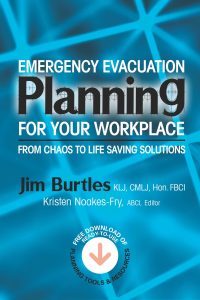
Contact Rothstein Associates, Inc. to request a complimentary copy to evaluate for classroom use.
Contents
Emergency Evacuation Planning for Your Workplace
Foreword by Melvyn Musson, FBCI, CDRP
Foreword by Steve Dance, CISA
Foreword by Vali Hawkins Mitchell, Ph.D., LMHC
0.1 Are You Prepared?
0.1.1 Does Your Company Have Effective Emergency Evacuation Plans and Procedures in Place?
0.1.2 Does Your Organization Have a Formally Agreed Upon Policy Regarding Emergency Evacuation of Your Premises?
0.1.3 Could Your Company be Deemed Guilty of Negligence in Regard to Protecting the Health and Safety of Those Who Use, Visit, or Reside in Your Premises?
0.2 Summary of How the Emergency Evacuation Planning Lifecycle Works
0.2.1 Phase 1 — Set up the Emergency Evacuation Planning Program
0.2.2 Phase 2 — Embed EEP into an Aware and Prepared Corporate Culture
0.2.3 Phase 3 — Explore, Assess, and Understand the Environment
0.2.4 Phase 4 — Agree Upon an Evacuation Strategy
0.2.5 Phase 5 — Develop Evacuation Plans and Procedures
0.2.6 Phase 6 — The Ongoing Program: Exercise and Maintain the EEP
0.3 EEP Is an Ongoing Process
Discussion Questions — Introduction
1.1 A Formal Methodology
1.1.1 The Lifecycle Model
1.1.2 Prerequisites
1.2 Program Management
1.2.1 Policy
1.2.2 Strategy
1.2.3 Tactics
1.2.4 Plans
1.2.5 Signage
1.2.6 Program Management Viewed as a System
1.3 Policy Development and Management Approval
1.3.1 A Practical Approach to Developing Policy
1.3.2 Gaining Support
1.3.3 Terms of Reference
1.4 Management Approval
1.4.1 The Initial Approach
1.4.2 Bidding for Permission
1.4.3 The Basic Argument
1.5 Making the Business Case
1.5.1 Create a Strong Business Document
1.5.2 Establish the Costs and Benefits
1.6 Managing EEP
1.6.1 Liaison with Other Services
1.6.2 Single Point of Contact
1.6.3 Communications
1.6.4 Security
1.6.5 Access Control
1.6.6 Inventory Control
1.7 Evacuation Triggers
1.7.1 Classes of Incidents that Warrant Evacuation
1.7.2 Six Emergencies Likely to Warrant an Evacuation
1.8 Coordination with Business Continuity Management
1.8.1 Similarities and Differences Between BCM and EEP
1.8.2 Key Differences
1.8.3 Common Ground
1.9 Obligations and Responsibilities
1.9.1 Legal Obligations
Phase 1 — Key Actions
Discussion Questions — Phase 1
2.1 BCI Good Practice Guidelines
2.1.1 What Is the message?
2.2.2 Training as an Ongoing Requirement
2.2 Developing the Training Program
2.3 Presenting the Training
2.4 Publicizing Within the Company
2.4.1 Message Strategy
2.4.2 Conveying the Message within the Organization
2.5 Aligning With Business Continuity
2.5.1 What to Do When a BC Program Is in Place
2.5.2 What to Do When No BC Program Is in Place
2.5.3 What to Do If You Decide to Take on BC
Phase 2 — Key Actions
Discussion Questions — Phase 2
3.1 Data Collection Parameters
3.1.1 Techniques
3.1.2 Physical Risk Assessment (PRA)
3.1.3 Emergency Impact Analysis (EIA)
3.1.4 Escape Requirements Analysis (ERA)
3.2 Physical Risk Assessment (PRA)
3.2.1 The Tour
3.2.2 The Outcome
3.2.3 Risk Register
3.3 Emergency Impact Analysis (EIA)
3.3.1 Facilitated Emergency Impact Analysis
3.3.2 Other Tactics
3.3.3 An EIA Checklist
3.4 Escape Requirements Analysis
Phase 3 — Key Actions
Discussion Questions — Phase 3
4.1 Gathering a Dimension of Environmental Data and Analyzing Necessary Information
4.1.1 Site Review Process
4.1.2 Assembly Area Requirements
4.1.3 Assembly Area Assessment and Selection
4.1.4 Characteristics of the Ideal Escape Route
4.2 Concerns for the Disabled
4.2.1 Elevators
4.2.2 Fire Compartmentalization
4.2.3 Temporary Waiting Space or Refuge
4.2.4 Managing Reasonable Adjustments
4.2.5 Mobility Impaired People
4.2.6 Hearing Impaired and Deaf People
4.2.7 Visually Impaired and Blind People
4.2.8 People with Cognitive Impairment
4.3 Planning for the Disabled
4.3.1 Plans for Mobility Impaired People
4.3.2 Plans for Hearing Impaired People
4.3.3 Plans for Visually Impaired and Blind People
4.3.4 Plans for People with Cognitive Impairment
4.4 Personal Emergency Egress or Escape Plans (PEEPs)
4.4.1 Communication and Training
4.4.2 Tailoring Plans to Suit Individual Needs
4.4.3 People with Special Requirements
4.4.4 People with Variable Requirements
4.4.5 People with Short-Term Requirements
4.4.6 Format for PEEPs
4.5 High-Rise Buildings
4.5.1 Categories of High-Rise buildings
4.5.2 Evacuation and Escape Ideas
4.5.3 Escape Chutes
4.5.4 Understanding EEP in the High-Rise Environment
4.5.5 A Practical Approach to Multi-Story Buildings
4.6 Signs and Signage
4.6.1 Styles of Signs
4.6.2 World-Wide Developments
Phase 4 Key Actions
Discussion Questions — Phase 4
5.1 Evacuation and Assembly
5.1.1 Preparation and Distribution of Emergency Evacuation Plans
5.1.2 Strategic and Tactical Planning — EMPs and ERPs
5.1.3 Operational Level Plans
5.1.4 Adapting Plans
5.1.5 A Standard Plan
5.1.6 Generic Plans
5.1.7 Tailored Plans
5.1.8 Emergency Evacuation Process and Timing
5.1.9 Emergency Evacuation Checklists
5.2 Making Sure Everybody is Safe
5.2.1 Emergency Marshals
5.2.2 Two Emergency Evacuation Scenarios
5.2.3 Pick the Right People
5.2.4 Train Them
5.2.5 Tools for the Job
5.2.6 Making Sure No One Is Left Behind
5.2.7 Refusing to Leave
5.2.8 Tracking Systems
5.3 Evacuation Plan Content
5.3.1 Common Content
5.3.2 Strategic Evacuation Planning
5.3.3 Triage
5.3.4 Tactical Concerns
5.4 Types of Premises
5.4.1 Large Building
5.4.2 Multi-Tenanted
5.4.3 Factory
5.4.4 Business Park
5.4.5 Retail Park
5.4.6 School
5.4.7 College Campus
5.4.8 Theatre or Cinema
5.4.9 Entertainment Complex
5.4.10 Secure Environments
5.5 Helping People Afterwards
5.5.1 Loss of Personal Property
5.5.2 Staff Help Desk
5.5.3 Reactions and Recovery
Phase 5 Key Actions
Discussion Questions — Phase 5
6.1 Peer Group Review
6.1.1 Review and Update
6.2 Test and Exercise Defined
6.2.1 Element Testing
6.2.2 End-to-End Testing
6.2.3 Exercising
6.3 A Delivery and Service Regime
6.3.1 Distribution
6.4 Conducting Tests and Exercises
6.4.1 Testing
6.4.2 The Launch Test
6.4.3 Exercising
6.5 Review and Update
6.6 “Smart” Fire Drills
6.6.1 On the Way Out
6.6.2 While They Are Out
6.6.3 Fire Exposure Analysis
6.6.4 Available Safe Egress Time (ASET) and Required Safe Egress Time (RSET
6.7 Case Study: United Grand Lodge of England
6.7.1 Hypothesis
6.7.2 An Estimation Procedure
6.7.3 The Final Plan
6.8 Emergency Notification
6.8.1 Signaling Protocol
6.8.2 Instructions
6.8.3 Coded Signals
Phase 6 Key Actions
Discussion Questions — Phase 6
Appendix A
Appendix B
How to Get Your Free Download
Contact Rothstein Associates, Inc. to request a complimentary copy to evaluate for classroom use.
Author
Jim Burtles, KLJ, MMLJ, FBCI, is a highly regarded global leader and practitioner in the Business Continuity profession with over 35 years of experience spread across 24 countries. He was one of founders of the Business Continuity Institute (BCI) and as its Standards Officer was heavily involved in the evolution of its professional standards and ethics. As an honorary fellow he now serves on the Global Membership Council representing the interests of the worldwide membership.
He received the freedom of the City of London in 1992 and his peers presented him with BCI’s Lifetime Achievement Award in 2001. In2005, he was granted the rank of a Knight of Grace in the Military and Hospitaller Order of St. Lazarus of Jerusalem, an ancient charitable body concerned with the treatment of skin diseases.
His first involvement with disaster recovery was in 1974 as a field engineer responsible for repairing and recovering a critical banking system struck by lightning. He went on to become IBM’s disaster recovery country specialist before joining a disaster recovery service as their principal emergency management consultant in 1987.
In 2001 he set out on his own as the principal of Total Continuity Management, where he now focuses on executive level training and the development of specialist emergency response skills.
Throughout all these years he tended to specialize in serving the personal needs of those involved in emergency situations. He trained and served as a trauma counselor before developing a counseling technique aimed at helping the victims of disaster-related trauma. This was published in 1998 as A Counselor’s Guide to the Restabilization Process. His practical experience includes hands-on recovery work with victims of such violent events as riots, bombings, earthquakes, storms, and fires. This includes technical assistance and support in 90-odd disasters, as well as advice and guidance for clients in over 200 emergency situations.
Through his activities as a trainer and consultant, he has helped to introduce the personal aspects of business continuity, emergency planning, and related disciplines into both the public and private sectors. He is the author of Principles and Practice of Business Continuity: Tools and Techniques (Rothstein Associates, 2007).
Jim Burtles can be contacted at [email protected] or +44(0)207-289-4491.
//old.rothstein.com/burtles-emergency-evacuation-planning/#contents
Instructor's Materials
Instructor Resources to accompany Emergency Evacuation Planning for Your Workplace are under development, with projected availability later in 2013.
Meanwhile, please note that the book includes useful teaching aids such as chapter learning objectives; chapter discussion questions; case studies and real-life examples; and a glossary.
Also, please note that a free sampling of the instructional materials will be made available to college instructors and corporate trainers considering this book for classroom use. However, our policy is to grant full access to all accompanying instructional materials via a license agreement and based on written confirmation that the book has been adopted as the required classroom text, with multiple copies ordered and name of college store or textbook vendor indicated.
Contact Rothstein Associates, Inc. to request a complimentary copy to evaluate for classroom use.
Reviews
Rothstein?s latest book aims to meet a critical need with a structured approach to emergency evacuations.
Writing about his own encounters with evacuations, author Jim Burtles expresses concern over the confusion that is so evident during an incident, and the widespread panic that can ensue when proper process is not put in place.
Burtles acquired his expertise in disaster recovery and emergency management through direct exposure to dozens of real-life disasters, almost a hundred emergencies and countless problem situations. He also benefited from the indirect experience of many more, gained from talking to, and working with, victims of various crises. In his current role, as director of Total Continuity Management, he is now working with senior executives of international corporations and government departments to help them develop complete emergency response plans and processes which include appropriate counselling and training programmes to cope with emergency situations.
The author?s extensive experience in this arena means he is well positioned to provide insight into the best practices that will ensure a plan is sustained via effective management, covering policy development together with processes for ongoing assurance and feedback.
This 300-page book lays out a six phase methodology for developing, testing and maintaining plans to ensure the safety and protection of people in the workplace.
Useful additions include a section on creating plans for mobility impaired and disabled people, legal requirements and planning in multi-tenanted buildings and public places. The book also features a full glossary and index for easy reference. Practical exercises and checklists throughout make this a thorough and useful addition to the business continuity and emergency management practitioner?s library.
~ Continuity Insurance & Risk?Magazine
?
Sometimes there just isn?t enough time, when only seconds count. Jim Burtles gives us a comprehensive blueprint for best chances for physical survival during any event that demands evacuation. It takes energy and stamina to be willing to stand up for human safety and survival, physical and emotional, and you can take this book as a strong ally into the fray. It?s a cutting edge methodology to plan and prepare for emergency evacuations.
As a trauma counselor who has worked at the sites of major disasters, I know that sudden emergencies can trigger extreme altered mental states that can lead to completely unpredictable behaviors. This is why I believe that excellent planning isn?t optional. In an altered state, most people don?t think clearly about options and are overwhelmed by their sudden powerlessness. In this book, Burtles provides a strong framework for the practice (and practice, practice, practice!) of well-planned evacuation drills and procedures, the writing and re-writing of strong policies, buy-on from top to bottom and from bottom to top, good signage, and clearly understood and agreed-upon methods that can give people at risk a sense of personal power that can significantly increase their chance of survival.
People with options tend to make different and better decisions than victims who feel powerless. If something unexpected happens and someone remembers the plan, others will also. Someone does the smart thing because a well constructed, relentlessly drilled plan is already in place, based on as many possible scenarios as humanly imaginable. Others will snap back to clear thinking, take the prepared action, and support others in shock and confusion to apply the plan. This clarity provides the best hope that the majority of people will follow to safety. These well-rehearsed behaviors become the default, the normal action in the middle of massive abnormality.?
~ Vali Hawkins Mitchell, PhD, LMHC, certified traumatolgist, consultant, executive coach, and author of The Cost of Emotions in the Workplace
Jim Burtles? book is so important and long-overdue. It provides a carefully wrought framework to formalize an activity that needs to be both structured and managed. With his long experience in business continuity planning, Burtles has applied his in-depth knowledge to emergency workplace evacuations. He demonstrates a six-phase methodology for developing, testing, and maintaining an effective evacuation plan.
Burtles? real-world experience also enables him to provide insights into best practices to ensure that your plan is sustained via effective management. He covers policy development along with processes for ongoing assurance and feedback. This approach creates an all-important management system that continues in place to protect the investment made in creating your plan.
The process of emergency evacuation has been overlooked for far too long. We cannot expect to evacuate our workplaces effectively without a commitment to time and resources to develop appropriate processes to support it. Yet, most traditional business continuity and incident management plans tend to assume that an effective evacuation will take place somehow, even when the plans have given very little attention to the process of actually getting staff and visitors out of the building to a place of safety. Burtles offers a reliable approach to ensure the safety and protection of our people in the workplace ? who are, after all, our greatest asset.?
~ Steve Dance, CISA, Owner, Risk Centric Chair, Business Continuity and Security SIG for the British Institute of Facilities Management
This new book will be a wakeup call, not only for those involved with BCM and EEP, but also anyone involved with employee safety, emergency response, physical security, and facilities management.
What has been painfully lacking or inadequate is a single source of good practical explanations, tips, examples, and customizable documentation. In this book, Burtles addresses that need. Not only does he give insights into what should be covered in an emergency evacuation plan, but he also provides a wealth of downloadable documentation that can be customized for an organization?s specific needs.
Burtles covers topics often not addressed in detail elsewhere, including:
- Regional evacuations, evacuation of downtown business areas, evacuation of college campuses and recreational complexes ? not just evacuation of individual buildings. He covers EEP for areas which are occupied by the same population most of the time, as well as those occupied primarily by visitors, shoppers, and guests.
- Potential post-evacuation employee issues and considerations, emphasizing that it entails every step that needs to be taken from the moment the alarm sounds until all the people involved are safely back at their desks, back in their homes, safe in an emergency shelter, or have become the responsibility of some other agency.
- Importance of Available Safe Egress Time (ASET) versus Required Safe Egress Time (RSET). Use Burtles? formulas to compare your ASET and RSET under various scenarios and see the results.
- Use of a clear development lifecycle similar to BCI?s business continuity management model. This model emphasizes the integration of BCM and EEP, applying the best practices reflected in the BCI model to researching, planning, and exercising a formal EEP.
- Reference, explanation, and use of the Plan-Do-Check-Act concept in EEP. This has already become a central point of reference for ongoing management systems and is now very much referenced in current business continuity standards.?
~ Melvyn Musson, FBCI, CDRP, Retired Senior Business Continuity Planning Manager, Edward Jones
Well-written and easy to understand, this volume deserves to be included in the core library of any emergency management professional, regardless of experience.
When an emergency occurs at a special event, an airport, a skyscraper, or some other venue, security professionals are confronted with controlling chaos and panic as they attempt to help frightened people move quickly and safely away from danger. Lives often depend on how well this is done.
Emergency evacuation is often given little consideration, yet after-action reports often point to shortcomings that need correction. Emergency Evacuation Planning for Your Workplace offers a thorough guide to preparing for evacuations. For more than 35 years, author Jim Burtles has been a respected authority on business continuity in all its forms.
Burtles provides details on how to deliver effective evacuation solutions for people of varying ages, health conditions, and special needs?the latter too frequently overlooked. He also reviews planning for and managing both immediate reactions and any long-term care for employees that may be required in the wake of major trauma.?
?Security Management Magazine, review by Mayer Nudell, Adjunct Professor in Security Management at Webster University; Certified Security Consultant and coauthor of The Handbook for Effective Emergency and Crisis Management.
Burtles, an expert on business continuity management, draws on his extensive global consulting experience with commercial facilities of every size, profit as well as not-for-profit, in writing this unique book on comprehensive emergency evacuation planning for the workplace. He provides an innovative approach to the strategic design and implementation of such plans, emphasizing the Business Continuity Institute?s 6-Phase Business Continuity Lifecycle Model. Burtles integrates continuity management concepts and evacuation planning into a step-by-step program to assist organizations in creating effective practices and procedures to respond to emergency evacuation needs.
Chapter 1, ?The Essentials of Emergency Evacuation Planning,? introduces the topic. The five following chapters address specific aspects of the planning and implementation process. Chapters are readable and formatted like those of a tax guide or law book, with excellent use of checklists, short summaries, case studies, vignettes, and discussion questions. Supplemental resources are available on the publisher?s website. Two appendices, ?An Auditing Approach to EEP? and ?Standards and Regulations,? and a glossary complete the book. Although oriented toward professional audiences, this work is an important guide and reference for anyone interested in workplace safety or emergency evacuation planning. Summing Up: Recommended. Upper-division undergraduate and two-year program students; professionals. ? S.R. Kahn, emeritus, University of Cincinnati.
~ Choice Magazine, Association of College and Research Libraries, a division of the American Library Association
Unique, comprehensive, important guide and reference for anyone interested in workplace safety and emergency evacuation planning. Recommended.?
~ Choice Magazine, Association of College and Research Libraries/American Library Association
//old.rothstein.com/burtles-emergency-evacuation-planning/#contents


